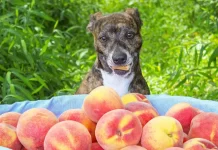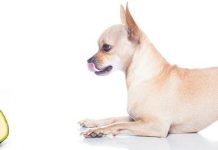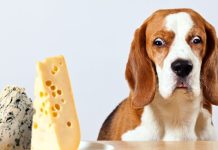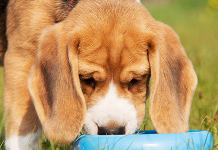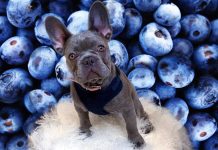When is a Redbone Coonoodle Full Grown?
A Redbone Coonoodle is considered full grown when it reaches its adult size and has completed its physical development. Generally, most Redbone Coonoodles reach their full size between 1.5 to 2 years of age. However, this can vary slightly from one dog to another, and some may take a bit longer to reach their full adult size.
It’s important to note that while a Redbone Coonoodle may be full grown in terms of size, their behavior and temperament can continue to mature and develop beyond this age. Training and socialization play an essential role in shaping a well-behaved adult Redbone Coonoodle.
What Impacts the Size of a Redbone Coonoodle?
The size of a Redbone Coonoodle is influenced by several factors, including:
Genetics: The most significant factor determining a dog’s size is its genetic makeup. The size of the parents and ancestors plays a crucial role in determining how big or small a Redbone Coonoodle will grow.
Breed Mix: As a mixed breed, the size of a Redbone Coonoodle can also be influenced by the other breed(s) it is mixed with. For example, if one of the parent breeds is smaller or larger, it can affect the size of the offspring.
Nutrition: Proper nutrition during a dog’s growth stages is essential for healthy development. High-quality dog food that meets the nutritional needs of growing puppies is crucial for reaching their full potential size.
Health and Wellness: Health issues or medical conditions during puppyhood can sometimes affect growth and development. Regular veterinary check-ups and addressing any health concerns promptly are essential.
Exercise: The amount of physical activity and exercise a Redbone Coonoodle receives during its development can impact muscle development and overall body condition, which can affect its size.
Neutering/Spaying: Early spaying or neutering of dogs can affect their growth plates, potentially leading to slightly different growth patterns and sizes compared to intact dogs.
Litter Size: The number of puppies in a litter can sometimes impact their growth and size, as there may be differences in the amount of nutrients each puppy receives while in the womb.
Environment: The environment in which the puppy grows up can also have an impact. A stable, nurturing environment with appropriate stimulation and socialization can contribute to overall healthy development.
It’s essential to remember that there can be some variation in size even within the same litter of Redbone Coonoodles due to genetic diversity. Monitoring their growth and consulting with a veterinarian can ensure they are growing at a healthy rate.

How Big Do Redbone Coonoodles Get?
The size of a Redbone Coonoodle can vary based on several factors, including genetics and the breeds of its parents. As a mixed breed, their size can be somewhat unpredictable, and individual dogs may vary in size even within the same litter. Generally, Redbone Coonoodles are medium to large-sized dogs.
On average, a fully grown Redbone Coonoodle can stand anywhere from 20 to 27 inches (50 to 68 cm) tall at the shoulder and weigh between 45 to 80 pounds (20 to 36 kg). However, some Redbone Coonoodles may fall outside this range and could be slightly smaller or larger, depending on their genetic makeup.
It’s essential to remember that there can be a considerable size difference between the parent breeds, the Redbone Coonhound and the Poodle. Therefore, the size of a Redbone Coonoodle can be influenced by which parent’s genes are more dominant.
If you are considering getting a Redbone Coonoodle, it’s a good idea to meet the puppy’s parents or inquire about the typical sizes of their previous litters to get an idea of what to expect in terms of size. Regular vet check-ups during their growth stages can also help track their development and ensure they are growing at a healthy rate.
When Do Redbone Coonoodles Stop Growing?
Redbone Coonoodles typically reach their full height and weight, and thus stop growing, between 1.5 to 2 years of age. However, it’s important to note that some individual dogs may continue to fill out and develop muscle mass beyond this age, even though their height may have stabilized.
The growth rate of Redbone Coonoodles can vary, and some may reach their adult size closer to 1.5 years, while others may take the full 2 years or slightly longer. Genetics and individual factors play a significant role in determining when a Redbone Coonoodle will stop growing.
During the growth phase, it’s important to provide them with a well-balanced diet, regular exercise, and proper veterinary care to support healthy development. As they approach adulthood, their nutritional needs may change, and it’s a good idea to consult with a veterinarian to ensure they are getting the right nutrition for their age and size.
When Do Redbone Coonoodles Calm Down?
The age at which Redbone Coonoodles begin to calm down can vary from dog to dog, and it is influenced by various factors, including genetics, individual temperament, training, and socialization. Generally, many Redbone Coonoodles start to show signs of calming down and becoming more settled as they reach adulthood, which is typically around 1.5 to 2 years of age.
During puppyhood and adolescence, Redbone Coonoodles are full of energy and may display more exuberant and playful behavior. As they mature, their energy levels often start to level off, and they become more focused and trainable. Adequate physical and mental exercise, along with consistent training and positive reinforcement, can help in shaping their behavior and promoting a calmer demeanor.
Socialization and exposure to various environments and stimuli are essential during their early months to instill confidence and reduce anxiety. A well-socialized Redbone Coonoodle is more likely to be calm and relaxed in various situations.
However, it’s important to remember that individual dogs may have different personalities, and some may remain more energetic and playful throughout their lives. Others may naturally be more mellow and laid-back from an early age. Providing regular exercise, mental stimulation, and a loving environment will help in fostering a well-balanced and well-behaved adult Redbone Coonoodle.
Do Males and Females Grow the Same Size?
In general, male and female Redbone Coonoodles will be similar in size, but there can be some variations between individuals. Both male and female Redbone Coonoodles are considered medium to large-sized dogs, and their size is primarily influenced by genetics and the breeds of their parents.
In some cases, male Redbone Coonoodles may be slightly larger and heavier than females, but this is not always the case. The difference in size between males and females, if present, is usually not significant.
It’s essential to note that size is just one aspect of a dog’s overall characteristics, and temperament, personality, and health are equally important considerations when choosing a pet.
If you have a preference for a specific size or have concerns about potential size differences, it’s a good idea to meet the puppy’s parents or inquire about the sizes of their previous litters to get an idea of what to expect. However, always remember that each individual dog is unique, and there can be variations even within the same litter.
How To Measure the size of a Redbone Coonoodle?
To measure the size of a Redbone Coonoodle, you’ll need a measuring tape or ruler that can measure in inches or centimeters. Here’s a step-by-step guide on how to measure your Redbone Coonoodle:
Height (Shoulder Height):
- Have your dog stand on a flat surface with all four legs squarely underneath them.
- Position the measuring tape or ruler vertically, starting from the ground up to the highest point of the dog’s shoulders (withers).
- Make sure the measuring tape is straight and not slanted to get an accurate measurement.
- Record the measurement in inches or centimeters.
Length (Body Length):
- Position your dog in a standing position, and then find the starting point, which is the base of the neck where it meets the shoulders.
- Gently run the measuring tape along your dog’s back, following the spine, all the way to the base of the tail.
- Make sure the measuring tape is touching the body without compressing the fur or skin.
- Record the measurement in inches or centimeters.
Weight:
- Weigh your dog using a pet scale or by stepping on a scale while holding your dog and then subtracting your weight from the total.
- For larger dogs, it’s best to use a platform or floor scale designed for pets to get an accurate weight reading.
Chest and Girth:
- Measure the circumference of your dog’s chest just behind the front legs at the widest part.
- Wrap the measuring tape around your dog’s chest, making sure it is snug but not too tight.
- Record the measurement in inches or centimeters.
Remember that these measurements can be useful for monitoring your dog’s growth, choosing the right-sized equipment like collars or harnesses, and tracking their overall health. If you are unsure about the correct way to measure your Redbone Coonoodle or have concerns about their size or growth, consulting with a veterinarian is always a good idea.
Redbone Coonoodle Life Expectancy
The life expectancy of a Redbone Coonoodle, like any mixed breed, can vary based on several factors, including genetics, overall health, and the care provided by the owner. On average, Redbone Coonoodles have a life expectancy of around 10 to 15 years.
To ensure your Redbone Coonoodle lives a long and healthy life, it’s essential to provide them with:
Proper Nutrition: Feed your dog a balanced and nutritious diet appropriate for their age, size, and activity level. High-quality dog food with the right balance of nutrients is crucial for their overall health.
Regular Exercise: Redbone Coonoodles are an energetic and active breed mix, so providing them with regular exercise and playtime is essential to keep them physically and mentally stimulated.
Veterinary Care: Schedule regular check-ups with a veterinarian to monitor your dog’s health, address any health concerns promptly, and keep up with vaccinations and preventive care.
Training and Socialization: Proper training and early socialization with other dogs and people are crucial for a well-adjusted and well-behaved adult Redbone Coonoodle.
Love and Attention: Dogs thrive on love and attention from their owners. Providing a loving and caring environment will contribute to their overall well-being and happiness.
Maintaining a Safe Environment: Keep your home and yard safe for your dog by removing any potential hazards or toxins that could harm them.
Remember that individual dogs may have different health conditions or genetic predispositions that can impact their lifespan. By providing them with proper care, regular health check-ups, and a happy and enriched life, you can maximize the chances of your Redbone Coonoodle living a long and fulfilling life.
Fun Facts About Redbone Coonoodles
The Redbone Coonoodle is not a recognized or well-known breed. It’s possible that new breeds or designer mixes may have emerged since then, but as an AI language model, I don’t have access to real-time data.
However, I can provide some fun facts about the parent breeds of the Redbone Coonoodle, the Redbone Coonhound, and the Poodle:
Redbone Coonhound:
- The Redbone Coonhound is an American breed known for its striking red coat and excellent hunting abilities. They were originally bred to track and tree raccoons and other small game.
- They are often called “Redbones” due to their distinct deep red coloration, which is uniform across their entire body.
- Redbone Coonhounds are known for their strong sense of smell, making them excellent scent hounds. They have been used in various hunting competitions and events.
- Their friendly and sociable nature makes them great family dogs, and they tend to get along well with children and other pets.
Poodle:
- Poodles are one of the most intelligent dog breeds in the world. They come in three sizes: Standard, Miniature, and Toy.
- Poodles have a curly, hypoallergenic coat, which means they shed less and are often considered more suitable for people with allergies.
- Poodles were originally bred as water retrievers in Germany, and their name comes from the German word “Pudel,” which means “to splash in water.”
- They excel in various canine sports and activities, including obedience, agility, and even water sports.
Please note that the Redbone Coonoodle is a mixed breed, and their specific characteristics and traits may vary depending on the individual dog and the combination of traits they inherit from each parent breed. Always consider adopting from reputable breeders or shelters and conduct thorough research about any specific breed or mix before bringing a new dog into your home.
Redbone Coonoodle Full Grown: Frequently Asked Questions
Q: When is a Redbone Coonoodle considered full grown?
A: Redbone Coonoodles are typically considered full grown between 1.5 to 2 years of age.
Q: How big do Redbone Coonoodles get?
A: Redbone Coonoodles are medium to large-sized dogs, and on average, they can stand between 20 to 27 inches (50 to 68 cm) tall at the shoulder and weigh between 45 to 80 pounds (20 to 36 kg).
Q: What is the life expectancy of a Redbone Coonoodle?
A: The life expectancy of a Redbone Coonoodle is typically around 10 to 15 years.
Q: Are Redbone Coonoodles good family pets?
A: Redbone Coonoodles can make excellent family pets, especially if they inherit the friendly and sociable nature of the Redbone Coonhound and the intelligence of the Poodle. They tend to get along well with children and other pets.
Q: Do Redbone Coonoodles shed a lot?
A: The shedding level of Redbone Coonoodles can vary depending on their coat type, which may be influenced by the coat of their Poodle parent. Poodles are known for their curly, hypoallergenic coat, which sheds less, so if the Redbone Coonoodle inherits this trait, they may shed minimally.
Q: How much exercise do Redbone Coonoodles need?
A: Redbone Coonoodles are an active breed mix, and they require regular exercise and mental stimulation to stay healthy and happy. Daily walks, playtime, and engaging activities are essential for this energetic breed.
Q: Are Redbone Coonoodles easy to train?
A: Training success can vary among individual dogs, but Redbone Coonoodles tend to be intelligent and trainable, especially if they inherit the Poodle’s smarts. Positive reinforcement training methods are often effective with this breed.
Q: Are Redbone Coonoodles good hunting dogs?
A: The Redbone Coonhound parent breed is an excellent hunting dog known for its tracking abilities. If a Redbone Coonoodle inherits these traits, they may exhibit hunting instincts and tracking skills.
Conclusion
In conclusion, the Redbone Coonoodle is a mixed breed that combines the Redbone Coonhound and the Poodle. As a mixed breed, their size, appearance, and temperament can vary based on genetics and individual factors. On average, Redbone Coonoodles are medium to large-sized dogs, known for their energetic and active nature.
They typically reach their full size between 1.5 to 2 years of age and have a life expectancy of around 10 to 15 years. Redbone Coonoodles can make wonderful family pets if provided with proper care, training, and socialization. Their intelligence and trainable nature, especially if they inherit the Poodle’s smarts, can make them responsive to positive reinforcement training.
While the Redbone Coonoodle is not a recognized breed, it’s essential to consider the characteristics of both parent breeds when choosing a mixed breed dog. If you are considering adopting a Redbone Coonoodle, it’s recommended to meet the puppy’s parents, research the breeds involved, and ensure you can provide the love and care needed to give them a happy and healthy life.
Remember that every dog is unique, and individual Redbone Coonoodles may have different temperaments and characteristics. By providing them with a loving and nurturing environment, regular veterinary care, and appropriate exercise, you can ensure they thrive and become cherished members of your family.


